+ データを開く
データを開く
- 基本情報
基本情報
| 登録情報 | データベース: PDB / ID: 3kl4 | ||||||
|---|---|---|---|---|---|---|---|
| タイトル | Recognition of a signal peptide by the signal recognition particle | ||||||
 要素 要素 |
| ||||||
 キーワード キーワード | HYDROLASE / signal recognition particle / SRP / SRP54 / Ffh / signal sequence / signal peptide / GTP-binding / Nucleotide-binding / Ribonucleoprotein / RNA-binding / Signal-anchor / Transmembrane | ||||||
| 機能・相同性 |  機能・相同性情報 機能・相同性情報Synthesis, secretion, and inactivation of Glucagon-like Peptide-1 (GLP-1) / 加水分解酵素; プロテアーゼ; ペプチド結合加水分解酵素; ジペプチジルペプチターゼ・トリペプチジルペプチターゼ / signal recognition particle / signal-recognition-particle GTPase / 7S RNA binding / SRP-dependent cotranslational protein targeting to membrane / dipeptidyl-peptidase activity / fungal-type vacuole membrane / aminopeptidase activity / protein processing ...Synthesis, secretion, and inactivation of Glucagon-like Peptide-1 (GLP-1) / 加水分解酵素; プロテアーゼ; ペプチド結合加水分解酵素; ジペプチジルペプチターゼ・トリペプチジルペプチターゼ / signal recognition particle / signal-recognition-particle GTPase / 7S RNA binding / SRP-dependent cotranslational protein targeting to membrane / dipeptidyl-peptidase activity / fungal-type vacuole membrane / aminopeptidase activity / protein processing / serine-type endopeptidase activity / GTPase activity / GTP binding / ATP hydrolysis activity / proteolysis / plasma membrane 類似検索 - 分子機能 | ||||||
| 生物種 |   Sulfolobus solfataricus (古細菌) Sulfolobus solfataricus (古細菌) | ||||||
| 手法 |  X線回折 / X線回折 /  シンクロトロン / シンクロトロン /  多波長異常分散 / 解像度: 3.5 Å 多波長異常分散 / 解像度: 3.5 Å | ||||||
 データ登録者 データ登録者 | Janda, C.Y. / Nagai, K. / Li, J. / Oubridge, C. | ||||||
 引用 引用 |  ジャーナル: Nature / 年: 2010 ジャーナル: Nature / 年: 2010タイトル: Recognition of a signal peptide by the signal recognition particle. 著者: Janda, C.Y. / Li, J. / Oubridge, C. / Hernandez, H. / Robinson, C.V. / Nagai, K. #1:  ジャーナル: Cell(Cambridge,Mass.) / 年: 1998 ジャーナル: Cell(Cambridge,Mass.) / 年: 1998タイトル: Crystal structure of the signal sequence binding subunit of the signal recognition particle. 著者: Keenan, R.J. / Freymann, D.M. / Walter, P. / Stroud, R.M. #2:  ジャーナル: Proc.Natl.Acad.Sci.USA / 年: 2003 ジャーナル: Proc.Natl.Acad.Sci.USA / 年: 2003タイトル: Crystal structure of the complete core of archaeal signal recognition particle and implications for interdomain communication. 著者: Rosendal, K.R. / Wild, K. / Montoya, G. / Sinning, I. #3:  ジャーナル: Science / 年: 2000 ジャーナル: Science / 年: 2000タイトル: Crystal structure of the ribonucleoprotein core of the signal recognition particle. 著者: Batey, R.T. / Rambo, R.P. / Lucast, L. / Rha, B. / Doudna, J.A. #4:  ジャーナル: Structure / 年: 2000 ジャーナル: Structure / 年: 2000タイトル: The crystal structure of the conserved GTPase of SRP54 from the archaeon Acidianus ambivalens and its comparison with related structures suggests a model for the SRP-SRP receptor complex. 著者: Montoya, G. / Kaat, K. / Moll, R. / Schafer, G. / Sinning, I. #5:  ジャーナル: Nature / 年: 2006 ジャーナル: Nature / 年: 2006タイトル: Following the signal sequence from ribosomal tunnel exit to signal recognition particle. 著者: Mario Halic / Michael Blau / Thomas Becker / Thorsten Mielke / Martin R Pool / Klemens Wild / Irmgard Sinning / Roland Beckmann /  要旨: Membrane and secretory proteins can be co-translationally inserted into or translocated across the membrane. This process is dependent on signal sequence recognition on the ribosome by the signal ...Membrane and secretory proteins can be co-translationally inserted into or translocated across the membrane. This process is dependent on signal sequence recognition on the ribosome by the signal recognition particle (SRP), which results in targeting of the ribosome-nascent-chain complex to the protein-conducting channel at the membrane. Here we present an ensemble of structures at subnanometre resolution, revealing the signal sequence both at the ribosomal tunnel exit and in the bacterial and eukaryotic ribosome-SRP complexes. Molecular details of signal sequence interaction in both prokaryotic and eukaryotic complexes were obtained by fitting high-resolution molecular models. The signal sequence is presented at the ribosomal tunnel exit in an exposed position ready for accommodation in the hydrophobic groove of the rearranged SRP54 M domain. Upon ribosome binding, the SRP54 NG domain also undergoes a conformational rearrangement, priming it for the subsequent docking reaction with the NG domain of the SRP receptor. These findings provide the structural basis for improving our understanding of the early steps of co-translational protein sorting. | ||||||
| 履歴 |
|
- 構造の表示
構造の表示
| 構造ビューア | 分子:  Molmil Molmil Jmol/JSmol Jmol/JSmol |
|---|
- ダウンロードとリンク
ダウンロードとリンク
- ダウンロード
ダウンロード
| PDBx/mmCIF形式 |  3kl4.cif.gz 3kl4.cif.gz | 96.5 KB | 表示 |  PDBx/mmCIF形式 PDBx/mmCIF形式 |
|---|---|---|---|---|
| PDB形式 |  pdb3kl4.ent.gz pdb3kl4.ent.gz | 74.3 KB | 表示 |  PDB形式 PDB形式 |
| PDBx/mmJSON形式 |  3kl4.json.gz 3kl4.json.gz | ツリー表示 |  PDBx/mmJSON形式 PDBx/mmJSON形式 | |
| その他 |  その他のダウンロード その他のダウンロード |
-検証レポート
| 文書・要旨 |  3kl4_validation.pdf.gz 3kl4_validation.pdf.gz | 438.8 KB | 表示 |  wwPDB検証レポート wwPDB検証レポート |
|---|---|---|---|---|
| 文書・詳細版 |  3kl4_full_validation.pdf.gz 3kl4_full_validation.pdf.gz | 470.3 KB | 表示 | |
| XML形式データ |  3kl4_validation.xml.gz 3kl4_validation.xml.gz | 21.3 KB | 表示 | |
| CIF形式データ |  3kl4_validation.cif.gz 3kl4_validation.cif.gz | 28.6 KB | 表示 | |
| アーカイブディレクトリ |  https://data.pdbj.org/pub/pdb/validation_reports/kl/3kl4 https://data.pdbj.org/pub/pdb/validation_reports/kl/3kl4 ftp://data.pdbj.org/pub/pdb/validation_reports/kl/3kl4 ftp://data.pdbj.org/pub/pdb/validation_reports/kl/3kl4 | HTTPS FTP |
-関連構造データ
| 関連構造データ | |
|---|---|
| 類似構造データ |
- リンク
リンク
- 集合体
集合体
| 登録構造単位 | 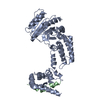
| ||||||||
|---|---|---|---|---|---|---|---|---|---|
| 1 |
| ||||||||
| 単位格子 |
| ||||||||
| 詳細 | Biological unit is the same as asymmetric unit. |
- 要素
要素
| #1: タンパク質 | 分子量: 48503.363 Da / 分子数: 1 / 断片: UNP residues 2-432 / 由来タイプ: 組換発現 / 由来: (組換発現)   Sulfolobus solfataricus (古細菌) / 株: P2 / 遺伝子: srp54, SSO0971 / プラスミド: pET15b / 発現宿主: Sulfolobus solfataricus (古細菌) / 株: P2 / 遺伝子: srp54, SSO0971 / プラスミド: pET15b / 発現宿主:  |
|---|---|
| #2: タンパク質・ペプチド | 分子量: 4533.361 Da / 分子数: 1 / 断片: UNP residues 26-51 / 由来タイプ: 組換発現 由来: (組換発現)  プラスミド: pET15b / 発現宿主:  参照: UniProt: P18962, 加水分解酵素; プロテアーゼ; ペプチド結合加水分解酵素; ジペプチジルペプチターゼ・トリペプチジルペプチターゼ |
-実験情報
-実験
| 実験 | 手法:  X線回折 / 使用した結晶の数: 2 X線回折 / 使用した結晶の数: 2 |
|---|
- 試料調製
試料調製
| 結晶 | マシュー密度: 2.65 Å3/Da / 溶媒含有率: 53.61 % |
|---|---|
| 結晶化 | 温度: 295 K / 手法: 蒸気拡散法 / pH: 5.5 詳細: 5-7 % PEG 4000, 100 mM Bis-Tris, 100 mM NaCl, 5-50 mM Mg(OAc)2, 2 % Polypropylene glycol P400. Crystals were obtained by seeding, pH 5.5, VAPOR DIFFUSION, temperature 295K |
-データ収集
| 回折 |
| ||||||||||||||||||
|---|---|---|---|---|---|---|---|---|---|---|---|---|---|---|---|---|---|---|---|
| 放射光源 |
| ||||||||||||||||||
| 検出器 |
| ||||||||||||||||||
| 放射 |
| ||||||||||||||||||
| 放射波長 |
| ||||||||||||||||||
| 反射 | 解像度: 3.5→58.42 Å / Num. all: 7683 / Num. obs: 7683 / % possible obs: 99.9 % / Observed criterion σ(I): 0 / 冗長度: 26.7 % / Biso Wilson estimate: 103.9 Å2 / Rmerge(I) obs: 0.081 / Net I/σ(I): 29.2 | ||||||||||||||||||
| 反射 シェル | 解像度: 3.5→3.69 Å / 冗長度: 27.1 % / Rmerge(I) obs: 0.762 / Mean I/σ(I) obs: 5.1 / Num. unique all: 1098 / % possible all: 100 |
- 解析
解析
| ソフトウェア |
| ||||||||||||||||||||||||||||||||||||||||||||||||||||||||||||||||||||||||||||||||||||||||
|---|---|---|---|---|---|---|---|---|---|---|---|---|---|---|---|---|---|---|---|---|---|---|---|---|---|---|---|---|---|---|---|---|---|---|---|---|---|---|---|---|---|---|---|---|---|---|---|---|---|---|---|---|---|---|---|---|---|---|---|---|---|---|---|---|---|---|---|---|---|---|---|---|---|---|---|---|---|---|---|---|---|---|---|---|---|---|---|---|---|
| 精密化 | 構造決定の手法:  多波長異常分散 / 解像度: 3.5→58.42 Å / 交差検証法: THROUGHOUT / 立体化学のターゲット値: Engh & Huber 多波長異常分散 / 解像度: 3.5→58.42 Å / 交差検証法: THROUGHOUT / 立体化学のターゲット値: Engh & Huber
| ||||||||||||||||||||||||||||||||||||||||||||||||||||||||||||||||||||||||||||||||||||||||
| 原子変位パラメータ | Biso mean: 151.852 Å2
| ||||||||||||||||||||||||||||||||||||||||||||||||||||||||||||||||||||||||||||||||||||||||
| Refine analyze |
| ||||||||||||||||||||||||||||||||||||||||||||||||||||||||||||||||||||||||||||||||||||||||
| 精密化ステップ | サイクル: LAST / 解像度: 3.5→58.42 Å
| ||||||||||||||||||||||||||||||||||||||||||||||||||||||||||||||||||||||||||||||||||||||||
| 拘束条件 |
| ||||||||||||||||||||||||||||||||||||||||||||||||||||||||||||||||||||||||||||||||||||||||
| LS精密化 シェル | Refine-ID: X-RAY DIFFRACTION / Total num. of bins used: 10
|
 ムービー
ムービー コントローラー
コントローラー



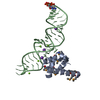



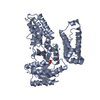


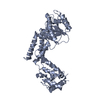
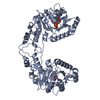
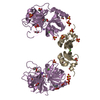

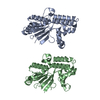

 PDBj
PDBj

